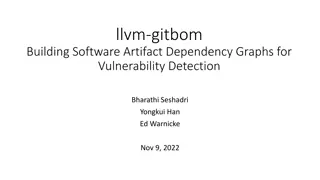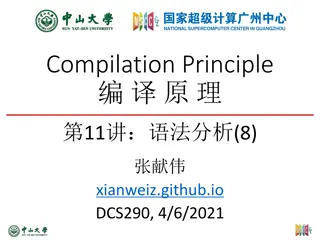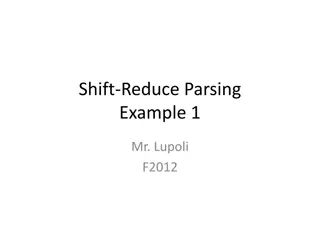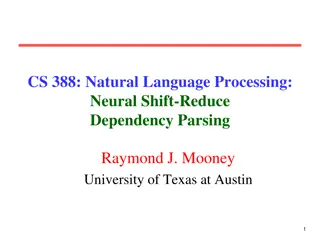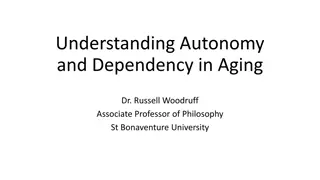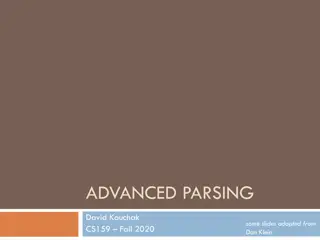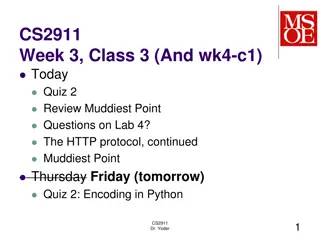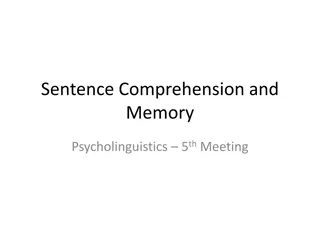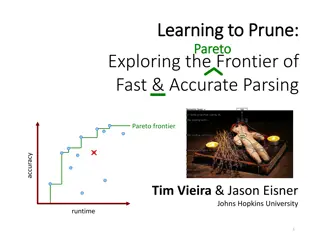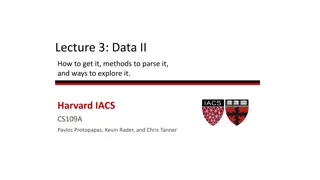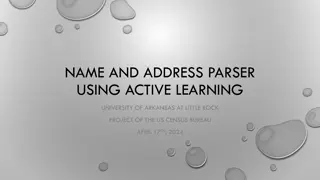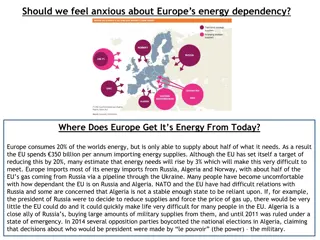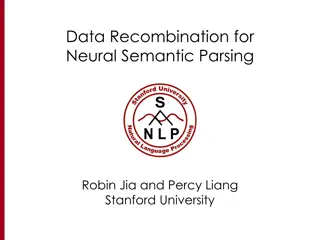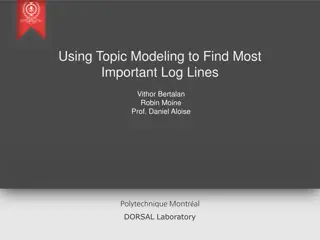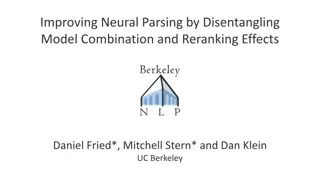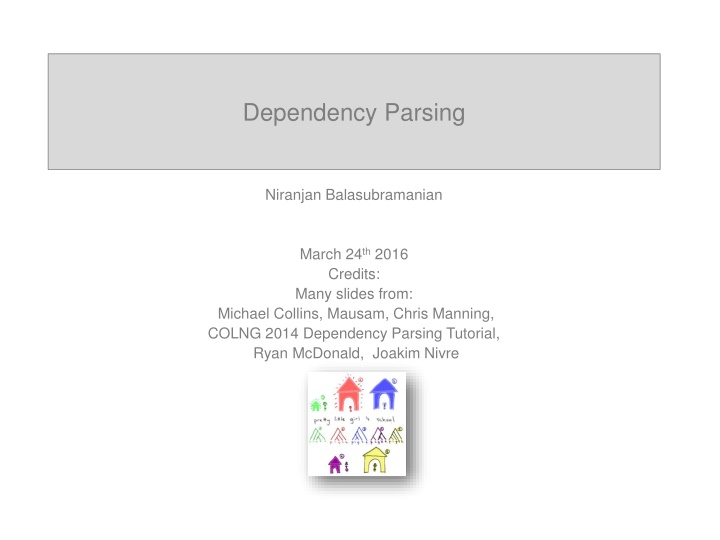
Dependency Parsing Techniques in NLP
Explore crucial concepts in dependency parsing, including lexical dependence, structural analysis, and parser evaluations. Learn about lexicalized parsers like the Charniak Parser, evaluation measures such as Labeled Precision and Recall, and the evolution of constituency parsers from early lexicalized versions to state-of-the-art advancements.
Uploaded on | 2 Views
Download Presentation

Please find below an Image/Link to download the presentation.
The content on the website is provided AS IS for your information and personal use only. It may not be sold, licensed, or shared on other websites without obtaining consent from the author. If you encounter any issues during the download, it is possible that the publisher has removed the file from their server.
You are allowed to download the files provided on this website for personal or commercial use, subject to the condition that they are used lawfully. All files are the property of their respective owners.
The content on the website is provided AS IS for your information and personal use only. It may not be sold, licensed, or shared on other websites without obtaining consent from the author.
E N D
Presentation Transcript
Dependency Parsing Niranjan Balasubramanian March 24th2016 Credits: Many slides from: Michael Collins, Mausam, Chris Manning, COLNG 2014 Dependency Parsing Tutorial, Ryan McDonald, Joakim Nivre
Dealing with independence issues Lexical dependence Lexicalize the rules add words to the rules. Structural dependence Add sub-categories e.g., VB use VBt, VBi, VBdetc. Add parent and sibling information e.g., Pr(NP NN | Parent(NP) = S)
Lexicalized Charniak Parser Identify heads of constituents and use them to condition probabilities. There are a handful of rules that specify how to identify heads. Probability of lexicalized parse tree is computed using these two quantities. Pr(cur_head = profits, rule=ri | cur_category = NP) = Pr(rule = ri | cur_head = profits, cur_category = NP) x Pr(cur_head = profits | cur_category = NP)
Constituency Parser Evaluations Use the gold tree (GT) annotations in Penn Tree Bank. For each test check if the predicted constituency tree (PT) matches the GT. Parsers almost always make mistakes. Allow for partial credit.
Constituency Parser Evaluations Break GT and PT into a set of constituents and their token spans. Compute precision and recall of the predicted constituents.
Evaluation Measures Labeled Precision (LP) Labeled Recall (LR) Labeled F1 = = = # of correctly labeled constituents in PT / |PT| # of correctly labeled constituents in PT / |GT| 2 LP x LR / (LP + LR)
Constituency Parser Evaluations Magerman 95 and Collins 96 -- Early lexicalized parsers Unlexicalized basic PCFG ~ 73.0 F1 Klein & Manning 03 -- PCFG + Various ways to encode structural and categorical preferences. Charniak 97 -- Lexicalized PCFG + State splitting Collins 99 -- Lexicalized parsing using heads From: Klein and Manning (2003)
Dependency Parsing Dependency tree A tree composed of the input words, which meets a few constraints: Single-head Connected Acyclic Projective Parse: Arcs don t cross each other. Mostly true for English. Non-projective Parse: Common in lang. w/ more flexible word order. German, Dutch, Czech etc.
Dependency Parsing Given an input sentence, draw edges between pairs of words, and label them. Result should be a tree. The edge-labels between word pairs should convey the correct syntactic relation. Convert PCFG parse to a dependency parse. Phrase structure can be deterministically transformed into dependency relations. Could construct a tree one edge at a time. Transition parsing. Could construct a fully connected tree, and prune it. Graph-based methods.
Transition Based Parsing Imagine a machine that has a stack and a buffer. It makes arc decisions about entries in the top of the stack and buffer. Keeps shifting words from the buffer until all words are consumed.
Transition-based Parsing Arc-Eager [Nivre 2003] Rules of the game! -- Keep moving items from buffer to stack. -- If the top item on stack is a dependent of the top buffer item output dependency relation and drop the item from stack. -- If the top buffer item is a dependent of any item in stack, move buffer item to stack, but keep the head in stack.
Example Transition Sequence Assume we have some black-box that takes two words and magically gives you the dependency relation between them if one exists.
Example Transition Sequence Shift: Move Economic to stack.
Example Transition Sequence Left Arc: Add left-arc amod(news, Economic) to A. Remove Economic from stack since it now has head in A. NOTE: Left-arc was possible only as Economic did not previously have a head in A.
Example Transition Sequence Shift Move news to stack.
Example Transition Sequence Left Arc: Add left-arc nsubj(had, news) to A. Remove news from stack since it now has head in A.
Example Transition Sequence Right Arc: Add right-arc root(ROOT, had) to A. Keep had in stack. NOTE: We are keeping had because it can have other dependents on the left.
Example Transition Sequence Shift: Black-box did not find any dependence relation for had and little.
Example Transition Sequence Left-arc: Add amod(effect, little) to A. Remove little from stack.
As a supervised classification task. Given the current state (i.e., stack, buffer and A) predict the next action. Can be viewed as a supervised learning problem. Four way classification (if un-typed dependencies) m-way classification, where m = 2 x number of types + 2 Features Compute features of the current configuration of the stack, buffer and A. Word in stack, POS of word, Word in buffer and POS of Word in buffer. Other features: Length of dependency arc Greedy classifier (no search involved) At each stage ask the classifier to predict the next transition. Select the best legal transition and apply it. Works quite well, close to PCFG. Quite fast! O(N) in length of sentence.
State-of-the-art Results From Chen and Manning (2014) Our parser Neural network based transition parser. UAS Unlabeled attachment scores LAS -- Labeled attachment scores
Summary Syntactic parsing aims to find phrase-structure in sentences and word-word relations. Constituency Group of words that behave as a unit. Context-free Grammar (CFG) to represent structure. Key Issue: Ambiguities, which lead to many many parses. Solution: Probabilistic CFG Score trees using probabilities on rules. Has lexical and structural dependence issues. Add fine-grained categories, include parents, lexicalize rules. Dependency Word-word relations e.g., nsubj(ate, Elephant). Parsing generates dependency trees by predicting edges or pruning edges. Transition-based parsing formulates edge prediction as a classification task. Predict one of four actions to take next. Parsing is a widely used step in constructing deeper, semantic representations.

